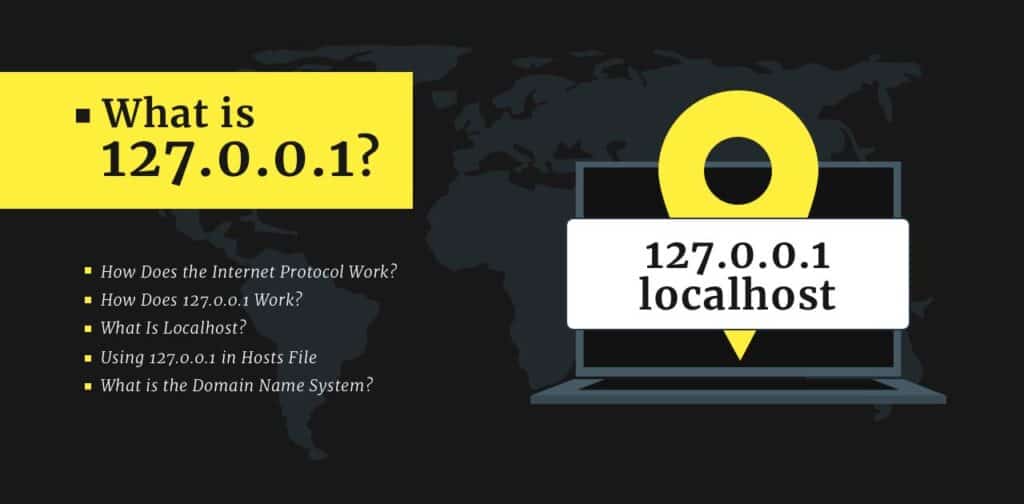When it comes to local development, testing, and networking communication, understanding how 127.0.0.1 and port numbers like 49342 work is essential. These concepts are the backbone of local environments for many developers, system administrators, and network engineers. In this in-depth guide, we will explore how 127.0.0.1:49342 is used in modern networking, how it interacts with services, and why it plays a pivotal role in local communication.
Whether you’re debugging a local web server, configuring an API, or setting up a virtual machine (VM), mastering the local loopback interface and port assignments can make your workflow smoother, faster, and more secure. Let’s dive deep into the technical and practical aspects of 127.0.0.1:49342, covering everything from port conflicts to firewall settings.
What is 127.0.0.1 and Why Does It Matter?
127.0.0.1 is a reserved IP address, often called “localhost.” It’s used to direct traffic back to your own device, allowing for local communication between services without accessing the internet. This is crucial for testing, debugging, and running applications securely on your own machine. In development, 127.0.0.1 helps simulate real network environments without external exposure.
Defining 127.0.0.1 – The Localhost

127.0.0.1 is a reserved IP address known as localhost. It’s part of the IPv4 address range specifically designated for internal communication within a device. Any data sent to 127.0.0.1 is looped back to the same machine, never reaching the external network. This makes it perfect for local development, testing, and localhost debugging.
Why 127.0.0.1 Is Important:
- Local Communication: 127.0.0.1 facilitates communication between services on the same machine, without requiring access to external networks.
- Security: Since it doesn’t leave your device, traffic on 127.0.0.1 is shielded from external threats.
- Development Environment: Developers frequently use 127.0.0.1 to simulate production environments in a local setting, especially when running web servers, APIs, and other applications.
The loopback interface is essential because it enables network sockets (used by different applications) to communicate internally. Applications like web browsers, web servers, and even APIs often bind to 127.0.0.1 for testing purposes. By ensuring traffic stays within the local system, 127.0.0.1 offers a reliable testing ground without affecting other network components.
How Loopback Interface Works
The loopback interface is a logical interface within the operating system that intercepts traffic intended for the localhost IP address. Instead of sending data out over the network, it immediately loops the traffic back to the device. Here’s how it functions:
- Data Flow: Any traffic sent to 127.0.0.1 is redirected back to the same machine, ensuring it doesn’t interact with external networks.
- Traffic Isolation: Since the loopback interface handles traffic within the device, it provides a secure sandbox for local testing.
- Low Latency: With no external routing involved, traffic within the local loopback interface is extremely fast.
Developers leverage the 127.0.0.1 address to test services like databases, APIs, or web servers without affecting the broader network environment. By ensuring all communication happens within the system, 127.0.0.1 provides an isolated environment for testing.
What is Port 49342 and Why Is It Important?
Port 49342 is a high-numbered port used for local communication between applications on the same device. It falls in the range of dynamic or temporary ports, which the system assigns automatically when needed. This makes it useful for testing or running services like web servers or APIs. Using port 49342 helps avoid conflicts with more common, fixed ports like 80 or 443. It’s a safe option for internal processes that don’t need external access. Developers often rely on it for secure, isolated testing.
Understanding Port Numbers
Port numbers represent specific channels through which data flows between devices or services. In the context of localhost debugging or networking communication, port numbers help direct traffic to the correct service. Think of a port as an entryway applications like web servers, APIs, or virtual machine networking services “listen” on specific ports for incoming data.
Read Also: Clevo PA71 Review – Best Budget-Friendly Gaming Laptop
Port 49342 – Dynamic and Ephemeral
Port 49342 falls within the range of ephemeral or dynamic ports (49152-65535). These ports are used by operating systems for temporary, short-lived communication. When an application initiates a connection and doesn’t specify a port, the OS assigns an ephemeral port from this range, which is where port 49342 comes into play.
Why Use Port 49342?
- Local Communication: Port 49342 is often assigned dynamically for local applications communicating internally.
- Availability: Being in the high range of dynamic ports, 49342 is less likely to interfere with standard ports used for other services (e.g., HTTP on port 80 or HTTPS on port 443).
- Temporary Assignments: Since it’s within the dynamic range, 49342 is typically assigned for temporary connections.
How Port Numbers Are Allocated
Port numbers are allocated based on the service type. Here’s a quick breakdown of how different ports are used:
| Port Range | Use | Examples |
|---|---|---|
| 0-1023 | Well-known ports | HTTP (80), HTTPS (443) |
| 1024-49151 | Registered ports | MySQL (3306), PostgreSQL (5432) |
| 49152-65535 | Dynamic/Ephemeral ports | Temporary/local connections (like 49342) |
Port 49342 often gets allocated for services running in temporary environments or for internal testing scenarios.
How Does the Local Loopback Interface Work?
The local loopback interface allows a device to communicate with itself using the IP address 127.0.0.1. When an application sends data to this address, it loops back to the same device instead of going out onto the network. This internal routing ensures that the data stays contained within the machine, making it ideal for local testing and debugging.

By using the loopback interface, developers can test network services, such as web servers or APIs, without affecting other network components. The communication is fast and secure, as no external routing or network exposure is involved. This setup provides a controlled environment where applications can interact safely and efficiently.
TCP/IP Stack and the Loopback Interface
The TCP/IP stack is responsible for managing how data is transmitted across a network. The loopback interface is an integral part of this stack, specifically designed for handling local traffic. By routing traffic back to the same device, it allows applications to communicate internally, providing a safe environment for testing services.
When traffic is sent to 127.0.0.1, the TCP/IP settings ensure the data stays within the machine. This is especially useful when running multiple services that need to interact without reaching out to external networks.
Benefits of the Loopback Interface
- Enhanced Security: Since no external networks are involved, using the loopback interface reduces the attack surface.
- Quick Response Times: Communication happens instantly because the data doesn’t travel through routers or external networks.
- Service Isolation: Different services can run on different ports without conflicting with one another, thanks to port number configuration.
The Role of 127.0.0.1 in Local Communication
When an application binds to 127.0.0.1, it listens exclusively for local connections. This ensures that no external devices can connect to that service unless explicitly allowed. For example, when running a local development environment for a web server, you can safely bind it to 127.0.0.1:49342, knowing it’s secure and isolated.

Example Use Case: A developer is working on an API and needs to test it without exposing it to the outside world. By binding the API to 127.0.0.1:49342, they can test all the functionality locally without any risk.
The Importance of 127.0.0.1:49342 in Modern Networking
127.0.0.1:49342 plays a crucial role in modern networking, particularly for development and testing. This combination uses 127.0.0.1 to direct traffic to the local machine, while 49342 is a high-numbered port that avoids conflicts with other services. This setup is essential for running and testing applications securely without impacting external networks.
In today’s tech landscape, 127.0.0.1:49342 is commonly used for local development environments, including web servers and APIs. It allows developers to simulate real-world scenarios in a controlled, isolated environment. This ensures that any testing or debugging does not interfere with live systems or expose vulnerabilities to the outside world.
Why Developers Use 127.0.0.1:49342
127.0.0.1:49342 is commonly used by developers for testing, debugging, and running applications locally. The combination of the localhost IP address and a high-numbered dynamic port ensures that traffic remains isolated and services can run without conflict.
Advantages:
- Local Communication: The loopback interface ensures that all communication happens within the same machine.
- Port Availability: High-numbered ports like 49342 reduce the likelihood of conflicts with other services.
- Flexibility: By using 127.0.0.1, developers can test their applications in a safe, isolated environment without affecting live systems.
Practical Use Cases in 2024
In 2024, local testing environments have evolved, but the fundamentals of 127.0.0.1 and dynamic port assignments like 49342 remain just as relevant. Whether it’s setting up local APIs, databases, or microservices, 127.0.0.1:49342 continues to provide a reliable environment for secure and isolated testing.
Changing Port Numbers and Why It Matters
Changing port numbers is often necessary to avoid conflicts between different services on the same machine. When two applications try to use the same port, they can interfere with each other, causing errors or connectivity issues. By assigning a unique port number, you ensure each service operates smoothly and independently.
It also helps in managing firewall settings and server configuration. Firewalls might block certain ports, so switching to an alternative port can bypass these restrictions. Additionally, in virtual machine networking, changing port numbers can prevent conflicts between the host and guest operating systems. This flexibility is crucial for maintaining a stable and secure development environment.
The Importance of Port Flexibility
Sometimes, you may need to change the port number for a service. This could be due to a port conflict, where another application is already using port 49342, or for specific firewall or server configuration reasons.
Reasons to Change Ports:
- Avoid Port Conflicts: If another application is using 49342, changing the port ensures smooth operation.
- Firewall Settings: Firewalls may block certain ports by default. Switching to a different port could help bypass these restrictions.
- Virtual Machine Networking: In a VM environment, you may need to map different services to different ports to prevent conflicts between the host and guest operating systems.
How to Change Port Numbers in Different OS
- Linux/Unix: Modify the service configuration files (e.g.,
/etc/services) or pass the port number as an argument during service startup. - Windows: Use PowerShell or modify configuration files to change port numbers for services.
- macOS: Similar to Linux, you can use the terminal to modify service configurations.
Common Problems and Solutions
Port conflicts can occur when multiple applications try to use the same port. To resolve this, check which ports are currently in use and choose a different port for your application if needed. Firewall issues might block certain ports; adjust your firewall settings to permit traffic on the desired port. Also, make sure your application’s configuration file correctly specifies the port. Correct any errors in the port settings to ensure smooth connectivity.
Troubleshooting Port Conflicts
- Check Active Ports: Verify which ports are in use to identify and resolve any conflicts.
- Reassign Ports: Choose a different port number if a conflict is detected to ensure your application functions properly.
Firewall and Security Issues
Sometimes, firewalls block ports, even on localhost. If you’re having trouble reaching 127.0.0.1:49342, check your firewall settings and allow the port.
Conclusion
Understanding 127.0.0.1:49342 and how it fits into the local loopback interface is essential for modern networking and development practices. Whether you’re setting up local web servers, debugging APIs, or managing services across virtual machines, mastering port configurations and local communication will streamline your workflow and prevent common pitfalls like port conflicts.
As you move forward with development, keep in mind the flexibility and power that 127.0.0.1 offers, especially when paired with ports like 49342.

Ashi is the site admin for “techitrusts.com” and specializes in writing within the journal category. If you need more detailed information about his background or work, feel free to ask!